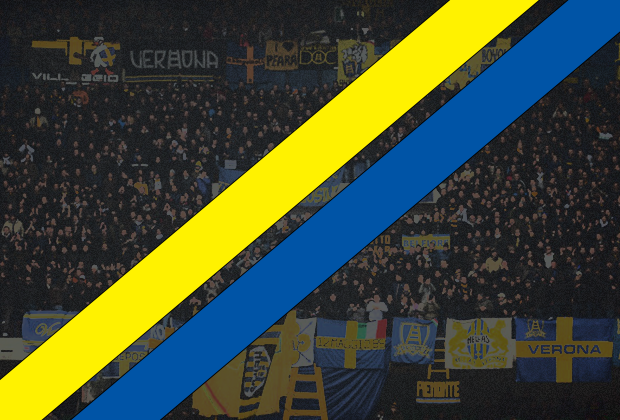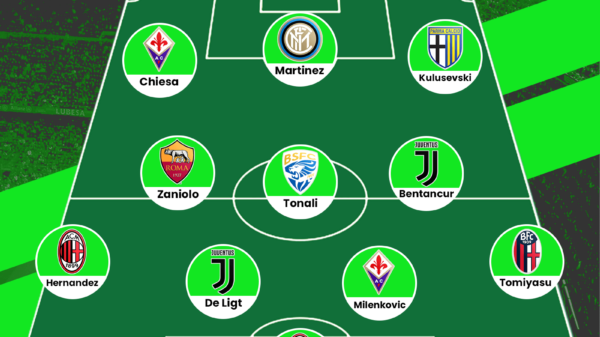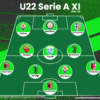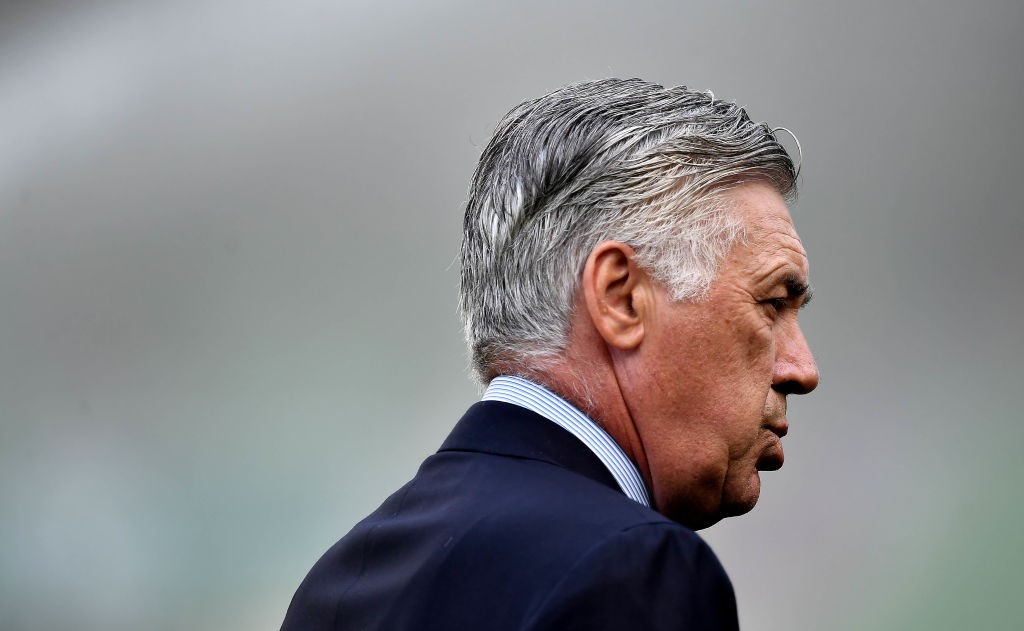Although not the first group of Ultras to be seen at Italy’s football scene, The Brigate Gialloblu grew strong and might during the latter half of the 1900s. Joseph Solomon talks about Hellas Verona and its very own Ultras.
Few cities and even fewer teams, have the ability to pierce fear into the hearts of opponents. The combination becomes much rarer, when the city has been awarded the status of World Heritage Site by UNESCO, and the team has been on the fringes of its national league for quite some time.
Welcome to Verona, the third largest city in northeast Italy, famous for being William Shakespeare’s setting for Romeo and Juliet and infamous for being a rat’s nest, when it comes to football.
Verona, is a perfect example of the Jekyll and Hyde nature of the Italians. Named after the river Vera, Verona, accommodates more than 265,000 people, all accustomed to the hypocrisy running deep in Italian veins. The city’s biggest club Hellas Verona, has been seen as a symbol of civic amour-propre, and has become Verona’s identity ever since the club’s inception way back in 1903.
In recent times, Hellas Verona, have often been left reeling in the fringes of Italy’s premier football competition, Serie A. Apart from three Coppa Italias, three Serie B championships and one Scudetto, the club has suffered torrid times and perhaps lying 15th in this season’s league, is more than evidence of itself. However, apart from on-field accolades, Hellas’ infamous, but rich traditional history, scarred by racism, fascism and violence, has the audacity to drive fear into the hearts of travelling teams and fans, even now.
It is impossible to exclude ‘Brigate Gialloblu (Yellow and Blue Brigade)’, when talking about the world of Italian ultras, or Global ultras, for that matter. The Brigate Gialloblu, has plagued Stadio Marcantonio Bentegodi, Hellas Verona’s home ground, ever since its formation in 1971. The Brigate, was one of the first groups of organized supporters in Italy, preceded only by the historic ‘Pit of Lions’ (AC Milan), Sampdoria’s Ultras and Inter’s Boys. Although fourth in its inception of organized fans, Brigate Gialloblu, has registered a perfect 10 on the Richter scale and edged the other three, massively.
The Brigate’s inception, clearly reflects the stature and perhaps the importance of ‘common men’, which became an integral part of its culture, hence becoming a symbol for the city of Verona. The Brigate, was founded at The Bar Olimpia Borgo Venezia by two sixteen year old boys, possibly student militants. In a time, when economy was booming and ‘money’ became the sole basis of discrimination, young teenagers saw this, this ‘Brigate’ as a perfect opportunity to express themselves and found solace in Curvas, wherein they could remove their social clothes and gather under the banner of Hellas Verona.
The Hooligan culture, was at an all-time high in England and it was perhaps fitting that the lowly suburbs of Verona then, turn their eyes to much pomp, glamour and razzmatazz in the form of London’s Chelsea. From the mid-seventies, Chelsea became the reference to follow and themes inspired by the Headhunters, Chelsea’s ultras or firm, was regularly witnessed inside the stadium of Verona. Apart from all the violence, that would ultimately indulge Hellas come 80s, the Brigate started with ‘choirs’ and ‘flags’ to support Hellas. Big hand sewn banners, largely composed of Blue and Yellow, with a Union Jack mark, engulfed the Curvas. Bass Drums and cymbals became a symbol of resistance, when the opposing team had the ball, and were seen as a ‘vogue’, which differentiated them from others. Thanks to the spread of English bands, a new lifestyle fused with a new style of clothing was consequently imported to the city of Verona, which was subsequently dubbed as ‘Liverpool of Italy’.
On this note, the Brigate rarely disappointed its cousins sitting far, beyond the channel, and took pro-actively to the stands. The size of the ultra subculture erupted suddenly and Brigate Gialloblu, became its premier harbinger. In parallel, the geography of violence also transited from inside the stadium to its exteriors, much like the British culture of settling affairs after the match. Slowly and gradually, the Hellas’ Curva Sud started to stand out in its increasing approach towards violence and scornful dealings with opposing fans. The stylized skull, Brigate’s symbol, became an emblem of fear, but above all respect. It is in the late 1970s, that the Brigate started to showcase guidelines of the first extreme right, despite being extreme left, at the time of its inception. Soon followed a political clash between two sets of ideologies, left and right, between Hellas’ Brigate and Bologna’s Curva, who stuck to their left tradition. Among the fist fights, flying kicks and battle with flag sticks, the Brigate are twinning in its first fight ever that will go down as a start of something horrific in the history of Hellas Verona and the Brigate itself.
After their first scuffle, the Brigate’s thirst of violence drastically increased and by the end of the 1970s, every game be it home or away, involving Hellas Verona was accompanied by riots, clashes and incidents. Parallel to match their insatiable hate for other fans, molotov cocktails, iron bars and chains, began to spout albeit hidden, in sections populated by Brigate. In the early eighties, the Brigate increasingly began to abandon their old matrix apolitical that had marked the origins and allowed survival in a time of struggle and radicalization. To distinguish themselves from the other Italian Ultras, the Brigate took the notion of swearing to a whole new level and used racism as one their persistent approach. Hence, in the 1982-1983 season, the Brigate played a protagonist in being the first ever support group, to use racism against players of black skin, in football. Cagliari’s Peruvian, Julio César Uribe, one of the first black players to play in Italy, was the victim of one of the most distasteful events in football history, when a banana was thrown at him.
A return to Serie A in 1983, re-ignited the historic derby with Napoli, which was often subjected to racist teasing. The northern Italians were often prejudiced when it came to southern Italians, in a time of political turmoil and Verona vs Napoli, was a perfect example of that. Slurs such as “Vesuvius rain down on them”, indicating to the volcano Vesuvius which is located in Naples, were common in Hellas’ Curva. Even when Diego Maradona played for the first time against Verona, he said: “We were greeted with a banner that made me suddenly understand that the match was not just about football.” The banner read “Welcome to Italy.”
On field success, marked even more rioting and animal like behavior and when Hellas won their historic Scuddeto in 1985, chaotic scenes were witnessed in Europe, which now became their playground. Nevertheless, a game against lowly Brescia in the Italian league, features the utmost atrocities of this animal like behavior. The ‘Lioness of Italy’ as Brescia is nicknamed, faced the furry of Hellas Verona’s ultra, when some Bresciani taunted 5,000 Hellas fans. The 5,000 strong army descended upon the city, with the sole aim of spreading chaos and anarchy. Damaging more than five hundred “enemy” cars and clashing violently with the police, the Veronesi left a trail of destruction in their wake. Consequently, the media dubbed these set of fans as ‘thugs’ and for the first time in Italy, a football fan was assimilated to a common criminal. The president of Verona at the time, Ferdinando Chiampan, called the fans criminals and threatened to withdraw the team from Serie A. The police shared this view and 12 arrests were made. At the house of one offender, political material of neo-fascist propaganda, as well as bats, helmets and improper weapons aimed clashes, were found. However, to portray their solidarity and mock the system, the Hellas curva displayed a “Not 12 but 5,000 guilty” banner, in their next fixture against AS Roma.
In 1991, following a tumultuous clash with Milan fans, the various parts of the Brigate Gialloblu unanimously decided to disband after some judges wanted to put the group on trial for being a “criminal organization”. Surprisingly, the attempt to curb Ultra power by judges backfired, and violence fused with racism erupted in abundance after Brigate’s dissolution. In 1996, the Verona derby featured, one of the most shocking incidents in global football. A black dummy, wearing Hellas Verona’s jersey was lowered down, hanging by the noose, hung on the railing of the curve, under the banner ‘Negro Go Away’. All this was done to contest and thwart away Hellas Verona’s increasing approach to sign Dutch defender Maickel Ferrier, who was black of leather. In the same period, flags with Celtic crosses and swastikas on red background started to appear. The Ultras’ persistent demeanor to resist players of black leathers, rightly earned them the tag of ‘The most racist fans in all of Italy’.
In recent times, the Ultras have eloped in an affair with humor, rather than taking it to streets. The fixture against Napoli, has rather brought a satirical best out of the Veronesi after they revealed a banner reading “Neapolitans… Sons of Juilet”. It was a humorous response to a previously unveiled Napoli banner which taunted Verona’s romantic heroine Juliet, proclaiming she was a whore. Still, violence is very much lurking in the shadows and clashes, although have receded are not uncommon.
The City of Verona, like the Shakespeare masterpiece Romeo and Juliet, has witnessed crime, notoriety, scandals and violence, but what sets the Veronese apart from the Shakespearean Masterclass, is their love for Hellas Verona, which seems to be immortal.
Written by Joseph Solomon
- Hellas Verona: The Brigate Gialloblu - February 3, 2015
- Watercarrier: An Evolved Position - January 28, 2015
- Can a three man defence work in the Premier League? - January 27, 2015



























































